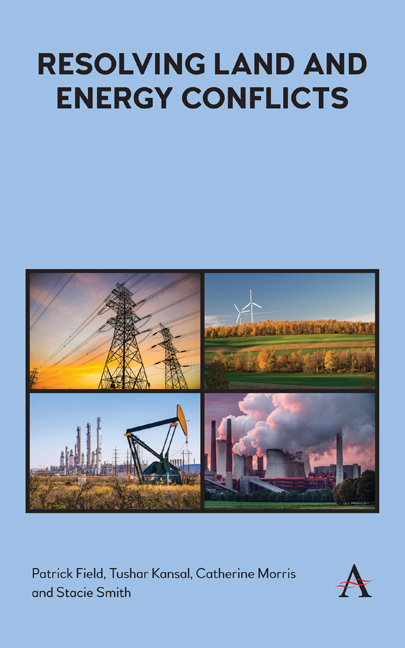Book contents
- Frontmatter
- Contents
- List of Illustrations
- About the Authors
- Acknowledgments
- 1 Introduction: The Complexity and Conflicts of Energy in the US Landscape
- 2 Land-Based Wind Energy Siting: The Not-So-Silent Wind
- 3 Nuclear Waste Siting: Getting Good People to Accept the Bad
- 4 Gas and Oil and Unconventional Shale: The New Old Frontier
- 5 The Linear Challenge: Transmission and Natural Gas Pipelines
- 6 Conclusions and Recommendations
- References
- Index
2 - Land-Based Wind Energy Siting: The Not-So-Silent Wind
Published online by Cambridge University Press: 29 May 2019
- Frontmatter
- Contents
- List of Illustrations
- About the Authors
- Acknowledgments
- 1 Introduction: The Complexity and Conflicts of Energy in the US Landscape
- 2 Land-Based Wind Energy Siting: The Not-So-Silent Wind
- 3 Nuclear Waste Siting: Getting Good People to Accept the Bad
- 4 Gas and Oil and Unconventional Shale: The New Old Frontier
- 5 The Linear Challenge: Transmission and Natural Gas Pipelines
- 6 Conclusions and Recommendations
- References
- Index
Summary
Introduction
Wind energy is an environmentally sustainable, cost-effective and renewable source of energy with high potential for expansion. As wind energy production expands, turbines are becoming larger, taller and more numerous, covering a larger geographical range and with greater concentration in high resource areas, thereby leading to greater public opposition from those whose interests or values are impacted. Their concerns include impacts on birds and other wildlife, aesthetics and viewsheds, noise and vibrations, human health, property values and the industrialization of rural and pristine landscapes. Due to limited systematic or consensus-based research on several of these topics, the prevalence and severity of the impacts of these are themselves often a source of dispute. Because of the broader political climate, many of the specific concerns about the adverse impacts of wind turbines on nearby residents have been swept up into a broader resistance to wind energy, based in skepticism about climate change, collusion of government and industry, concerns about cost-effectiveness or support for oil and gas development. A highly variable and inconsistent regulatory environment also exacerbates conflicts, with the greatest control sometimes situated at the local level, which leads to case-bycase decision making that suffers from limited technical capacity and is subject to greater local pressure. In many areas, pro-wind and anti-wind advocates have become locked in a fight where both sides ultimately deny the evidence, experiences and realities of the other.
In the face of these growing conflicts, some models for collaborative resolution are emerging. Collaboration between the wind industry and wildlife advocates, such as that pursued by the American Wind Wildlife Institute (see case study) and the Bats and Wind Energy Cooperative, has gone a long way toward understanding, mitigating and reducing wind energy's impact on wildlife. Improved early engagement of stakeholders in state and local siting policy and decision-making, joint fact-finding on areas of uncertainty, clarified regulatory frameworks and expanded public dialogue on energy needs and trade-offs also hold promise for managing wind energy siting disputes.
The Scale of Wind Energy
Wind energy is the fastest growing energy source in the world and has seen enormous growth in the United States over the past few decades.
- Type
- Chapter
- Information
- Resolving Land and Energy Conflicts , pp. 15 - 38Publisher: Anthem PressPrint publication year: 2018



